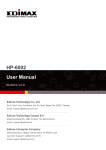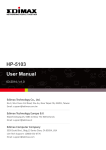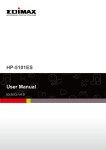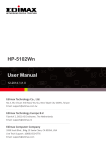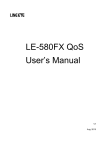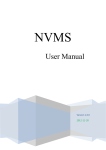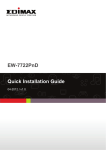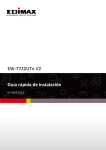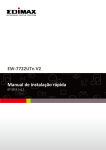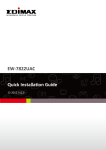Download Edimax HP-6002AC
Transcript
HP-6002AC User Manual 03-2014 / v1.0 COPYRIGHT Copyright Edimax Technology Co., Ltd. all rights reserved. No part of this publication may be reproduced, transmitted, transcribed, stored in a retrieval system, or translated into any language or computer language, in any form or by any means, electronic, mechanical, magnetic, optical, chemical, manual or otherwise, without the prior written permission from Edimax Technology Co., Ltd. Edimax Technology Co., Ltd. makes no representations or warranties, either expressed or implied, with respect to the contents hereof and specifically disclaims any warranties, merchantability, or fitness for any particular purpose. Any software described in this manual is sold or licensed as is. Should the programs prove defective following their purchase, the buyer (and not this company, its distributor, or its dealer) assumes the entire cost of all necessary servicing, repair, and any incidental or consequential damages resulting from any defect in the software. Edimax Technology Co., Ltd. reserves the right to revise this publication and to make changes from time to time in the contents hereof without the obligation to notify any person of such revision or changes. The product you have purchased and the setup screen may appear slightly different from those shown in this QIG. For more information about this product, please refer to the user manual on the CD-ROM. The software and specifications are subject to change without notice. Please visit our website www.edimax.com for updates. All brand and product names mentioned in this manual are trademarks and/or registered trademarks of their respective holders. Edimax Technology Co., Ltd. Add: No. 3, Wu-Chuan 3rd Rd., Wu-Ku Industrial Park, New Taipei City, Taiwan Tel: +886-2-77396888 Email: [email protected] 1 Contents Chapter 1: Introduction ..................................................................................................................................... 3 1.1 Product Features .................................................................................................................................. 3 1.2 Application ........................................................................................................................................... 3 1.3 Compatibility ........................................................................................................................................ 4 1.4 System Requirements .......................................................................................................................... 4 Chapter 2: Interfaces ......................................................................................................................................... 5 2.1 LEDs ...................................................................................................................................................... 5 2.2 Button .................................................................................................................................................. 5 2.3 Gigabit Ethernet Port ........................................................................................................................... 6 Chapter 3:Utility Software Installation .............................................................................................................. 7 3.1 Win 8 .................................................................................................................................................... 7 3.2 Win XP/Vista / 7 ................................................................................................................................. 14 Chapter 4: Using the Utility Software .............................................................................................................. 20 4.1 Main Tab ............................................................................................................................................ 20 4.2 Diagnostics Tab .................................................................................................................................. 21 4.3 About Tab ........................................................................................................................................... 22 Chapter 5: Group Button ................................................................................................................................. 23 5.1 Forming a HomePlug AV Logical Network ......................................................................................... 23 5.2 Joining a Network .............................................................................................................................. 24 5.3 Leaving a Network & Joining another Network ................................................................................. 25 Chapter 6: Troubleshooting ............................................................................................................................. 26 2 Chapter 1: Introduction 1.1 Product Features • High-speed data transfer rate of up to 600Mbps, ideal for bandwidth-intensive HD video or 3D video streaming and online gaming • Features energy saving mode to reduce power consumption • Up to 300-meter range over a home's electrical circuit for better performance through walls or across floors • Built-in QoS assures the quality of bandwidth sensitive applications such as voice, video and online games • Supports IGMP managed multicast IP transmission, optimizing IPTV streaming • Compatible with all AV500 & AV200 Powerline adapters (HomePlug AV) • Integrated power socket with noise filter 1.2 Application High-definition (HD) and standard-definition (SD) video distribution Broadband Internet sharing Internet Protocol Television (IPTV) and Voice over Internet Protocol (VoIP) applications 3 1.3 Compatibility AV600 powerline devices (HomePlug AV standard) are incompatible and cannot be used with 14Mbps and 85Mbps powerline devices (HomePlug 1.0 and 1.1 standards). 1.4 System Requirements Operating System CPU RAM Free Disk Space Network Interface Utility supports Windows XP/Vista/7/8 Intel Pentium III 1.0GHz (or above) 256MB (or above) 100MB (or above) Ethernet port (100Mbps or above) and an Ethernet cable 4 Chapter 2: Interfaces 2.1 LEDs LED Status Green Blinking LAN1-3 Off Green PLC PWR Off Green Off Description LAN port connected LAN activity (transferring data) LAN port not connected The green indicator turns on and the green indicator turns blinks slowly when the device is detecting a powerline link. The green indicator turns on and the green indicator turns blinks quickly to indicate data is being transferred over the powerline link. No other PLC device detected Powered on Powered off 2.2 Button Interface Integrated Power Socket Description The integrated electrical socket enables additional terminal devices or multiple socket to be connected to 5 Ethernet Port Group Reset the adapter, just as a normal wall socket would. This is a Gigabit Ethernet port for connecting to a computer or other devices with a network port. Creates an encrypted powerline network group automatically (press the button for less than 3 seconds). Leaves an encrypted powerline network group (press the button for 8~12 seconds). Restores the powerline adapter to factory defaults (press the button for 8~12 seconds). 2.3 Gigabit Ethernet Port You can connect the powerline adapter to a router, a computer, or any network device via this Gigabit Ethernet port. 6 Chapter 3:Utility Software Installation 3.1 Win 8 Step 1 Before installing the utility software, make sure that no other powerline utility is installed on your computer. If any other utility software is installed, uninstall it and reboot the computer. Step 2 Insert the CD into your CD-ROM drive. When the following EZmax Wizard appears, select your model. Step 3 Then click “Setup Utility”. 7 Step 4 Click right button on WinPCap4.1.2 then click “Properties”. Step 5 Click Compatibility tab and check “Run this program in compatibility mode for:", then select Windows 7, then click “Apply”. Step 6 Then click “WinPcap_4_1_2”. The wizard will guide you through the setup process. 8 Step 7 When the following WinPcap Compatibility Assistant appears, select Run the program without getting help. 9 Step 8 After the installation is complete, click “Finish”. 10 Step 9 Click the “Edimax PowerLine Utility”, the “PLC AV600 Utility” appears, click “Next” to continue. 11 Step 10 Select where you want to install the utility software, and then click “Next”. Step 11 After the installation is complete, click “Close”. 12 Step 12 An icon will appear on your desktop. Click the icon to open the utility software. Note: You can manage all the connected powerline adapters with the utility software. However, installing the utility software is optional. 13 3.2 Win XP/Vista / 7 Step 1 Before installing the utility software, make sure that no other powerline utility is installed on your computer. If any other utility software is installed, uninstall it and reboot the computer. Step 2 Insert the CD into your CD-ROM drive. When the following EZmax Wizard appears, select your model. Step 3 Then click “Setup Utility”. 14 Step 4 If you have not installed WinPcap version 4.1.2 (or higher) on your computer before. The wizard will guide you through the setup process. 15 16 Step 5 When the “Edimax PowerLine Utility” setup wizard appears, click “Next” to continue. Step 6 In the “License Agreement” screen, please select “I Agree” and then click “Next” to continue. 17 Step 7 Select where you want to install the utility software, and then click “Next”. Step 8 If you confirm to install the utility, click “Next”. 18 Step 9 After the installation is complete, click “Close”. Step 10 An icon will appear on your desktop. Click the icon to open the utility software. Note: You can manage all the connected powerline adapters with the utility software. However, installing the utility software is optional. 19 Chapter 4: Using the Utility Software 4.1 Main Tab The “Main” tab provides a list of powerline adapters connected to the network. The upper panel displays local powerline adapters. The lower panel displays remote powerline adapters in the network. Set Name Enter Password Scan Select a device and click “Set Name” to rename the device. By default, this column is blank. Select a device and click “Enter Password” to set up a password for the device. Click “Scan” and the utility software will perform an immediate scan of other remote powerline adapters. By default, the utility automatically scans every few seconds. 20 4.2 Diagnostics Tab The “Diagnostics” tab displays the system information and history of all remote devices. The upper panel displays technical data concerning the software and hardware on the host computer and the lower panel displays the history of all remote devices. 21 4.3 About Tab The “About” tab contains some basic information about the software. You can also enable or disable the autoscan function under “Preferences”. 22 Chapter 5: Group Button This section demonstrates how to add or remove devices from a HomePlug AV network with the “Group” button. 5.1 Forming a HomePlug AV Logical Network When two devices with different group keys are connected to the same powerline and you want them to form a logical network, follow the following procedures: Step 1 Press and hold the “Group” button on adapter A for less than 3 seconds. The Power LED will start to blink. Step 2 Within 120 seconds after the Power LED starts blinking on adapter A, press the “Group” button on adapter B for less than 3 seconds. Step 3 Wait for the connection to be established. 23 5.2 Joining a Network If you want to add a new powerline device to an existing network, follow the following procedures: Step 1 Press the “Group” button on an adapter in the existing network (adapter A or B) for less than 3 seconds. The Power LED will start to blink. Step 2 Within 120 seconds after the Power LED starts blinking on adapter A or B, press the “Group” button on the new adapter (adapter C) for at least 3 seconds. Step 3 Wait for the connection to be established. 24 5.3 Leaving a Network & Joining another Network If you want to remove a powerline device from an existing network and add it to another network, follow the following procedures: Step 1 Press the “Group” button on the adapter to be removed (adapter B) for at least 10 seconds. Step 2 Wait for adapter B to be disconnected with adapter A & C. Step 3 Press the “Group” button on an adapter in another network (adapter D) for less than 3 seconds. The Power LED will start to blink. Step 4 Within 120 seconds after the Power LED starts blinking on adapter D, press the “Group” button on adapter B for at least 3 seconds. Step 5 Wait for the connection to be established. 25 Chapter 6: Troubleshooting If your powerline adapters have difficulty communicating with each other, try the following procedures: Try power cycling the unit by unplugging it from the electric outlet for 10 seconds and plugging it in again. Use a pin to hold the reset button down for 2 seconds on each unit you are trying to connect. The units will reset and attempt to establish a connection using factory default settings. Try plugging the powerline adapter into an adjacent electric outlet. Powerline adapters work better when plugged directly into an electric outlet. Using a power strip or surge protector may degrade network performance or completely block network signals. This powerline adapter should not be used on GFI protected electric outlets, as some outlets will filter out the powerline signal. This powerline adapter should not be used in areas with excessive heat. Certain florescent or incandescent lights are noise sources that can degrade performance. If your building has more than one circuit breaker box, your powerline adapters may not be able to establish a connection across different circuit breaker boxes. In such cases, try establishing a connection across different circuit breaker boxes by linking two powerline adapters together with an Ethernet cable. 26 Federal Communication Commission Interference Statement This equipment has been tested and found to comply with the limits for a Class B digital device, pursuant to Part 15 of FCC Rules. These limits are designed to provide reasonable protection against harmful interference in a residential installation. This equipment generates, uses, and can radiate radio frequency energy and, if not installed and used in accordance with the instructions, may cause harmful interference to radio communications. However, there is no guarantee that interference will not occur in a particular installation. If this equipment does cause harmful interference to radio or television reception, which can be determined by turning the equipment off and on, the user is encouraged to try to correct the interference by one or more of the following measures: 1. Reorient or relocate the receiving antenna. 2. Increase the separation between the equipment and receiver. 3. Connect the equipment into an outlet on a circuit different from that to which the receiver is connected. 4. Consult the dealer or an experienced radio technician for help. FCC Caution This device and its antenna must not be co-located or operating in conjunction with any other antenna or transmitter. This device complies with Part 15 of the FCC Rules. Operation is subject to the following two conditions: (1) this device may not cause harmful interference, and (2) this device must accept any interference received, including interference that may cause undesired operation. Any changes or modifications not expressly approved by the party responsible for compliance could void the authority to operate equipment. Federal Communications Commission (FCC) Radiation Exposure Statement This equipment complies with FCC radiation exposure set forth for an uncontrolled environment. In order to avoid the possibility of exceeding the FCC radio frequency exposure limits, human proximity to the antenna shall not be less than 2.5cm (1 inch) during normal operation. Federal Communications Commission (FCC) RF Exposure Requirements SAR compliance has been established in the laptop computer(s) configurations with PCMCIA slot on the side near the center, as tested in the application for certification, and can be used in laptop computer(s) with substantially similar physical dimensions, construction, and electrical and RF characteristics. Use in other devices such as PDAs or lap pads is not authorized. This transmitter is restricted for use with the specific antenna tested in the application for certification. The antenna(s) used for this transmitter must not be co-located or operating in conjunction with any other antenna or transmitter. R&TTE Compliance Statement This equipment complies with all the requirements of DIRECTIVE 1999/5/EC OF THE EUROPEAN PARLIAMENT AND THE COUNCIL of March 9, 1999 on radio equipment and telecommunication terminal equipment and the mutual recognition of their conformity (R&TTE). The R&TTE Directive repeals and replaces in the directive 98/13/EEC (Telecommunications Terminal Equipment and Satellite Earth Station Equipment) As of April 8, 2000. Safety This equipment is designed with the utmost care for the safety of those who install and use it. However, special attention must be paid to the dangers of electric shock and static electricity when working with electrical equipment. All guidelines of this and of the computer manufacture must therefore be allowed at all times to ensure the safe use of the equipment. EU Countries Intended for Use The ETSI version of this device is intended for home and office use in Austria, Belgium, Bulgaria, Cyprus, Czech, Denmark, Estonia, Finland, France, Germany, Greece, Hungary, Ireland, Italy, Latvia, Lithuania, Luxembourg, Malta, Netherlands, Poland, Portugal, Romania, Slovakia, Slovenia, Spain, Sweden, Turkey, and United Kingdom. The ETSI version of this device is also authorized for use in EFTA member states: Iceland, Liechtenstein, Norway, and Switzerland. EU Countries Not Intended for Use None 27 EU Declaration of Conformity English: This equipment is in compliance with the essential requirements and other relevant provisions of Directive 2004/108/EC, 2009/125/EC. Cet équipement est conforme aux exigences essentielles et autres dispositions de la directive Français: 2004/108/EC, 2009/125/EC Čeština: Toto zařízení je v souladu se základními požadavky a ostatními příslušnými ustanoveními směrnic 2004/108/EC, 2009/125/EC. Polski: Urządzenie jest zgodne z ogólnymi wymaganiami oraz szczególnymi warunkami określonymi Dyrektywą UE 2004/108/EC, 2009/125/EC. Română: Acest echipament este în conformitate cu cerinţele esenţiale şi alte prevederi relevante ale Directivei 2004/108/EC, 2009/125/EC. Русский: Это оборудование соответствует основным требованиям и положениям Директивы 2004/108/EC, 2009/125/EC. Magyar: Ez a berendezés megfelel az alapvető követelményeknek és más vonatkozó irányelveknek (2004/108/EC, 2009/125/EC) Türkçe: Bu cihaz 2004/108/EC, 2009/125/EC direktifleri zorunlu istekler ve diğer hükümlerle ile uyumludur. Українська: Обладнання відповідає вимогам і умовам директиви 2004/108/EC, 2009/125/EC. Slovenčina: Toto zariadenie spĺňa základné požiadavky a ďalšie príslušné ustanovenia smerníc 2004/108/EC, Deutsch: Español: 2009/125/EC. Dieses Gerät erfüllt die Voraussetzungen gemäß den Richtlinien 2004/108/EC, 2009/125/EC. El presente equipo cumple los requisitos esenciales de la Directiva 2004/108/EC, 2009/125/EC. Italiano: Questo apparecchio è conforme ai requisiti essenziali e alle altre disposizioni applicabili della Direttiva 2004/108/EC, 2009/125/EC. Nederlands: Dit apparaat voldoet aan de essentiële eisen en andere van toepassing zijnde bepalingen van richtlijn 2004/108/EC, 2009/125/EC. Português: Norsk: Svenska: Dansk: Suomi: Este equipamento cumpre os requesitos essênciais da Directiva 2004/108/EC, 2009/125/EC. Dette utstyret er i samsvar med de viktigste kravene og andre relevante regler i Direktiv 2004/108/EC, 2009/125/EC. Denna utrustning är i överensstämmelse med de väsentliga kraven och övriga relevanta bestämmelser i direktiv 2004/108/EC, 2009/125/EC. Dette udstyr er i overensstemmelse med de væ sentligste krav og andre relevante forordninger i direktiv 2004/108/EC, 2009/125/EC. Tämä laite täyttää direktiivien 2004/108/EC, 2009/125/EC oleelliset vaatimukset ja muut asiaankuuluvat määräykset. WEEE Directive & Product Disposal At the end of its serviceable life, this product should not be treated as household or general waste. It should be handed over to the applicable collection point for the recycling of electrical and electronic equipment, or returned to the supplier for disposal. 28 29































